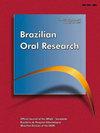内因和外因因素与成人牙齿侵蚀磨损的关系:一项横断面研究。
IF 2.5
4区 医学
Q2 Dentistry
引用次数: 1
摘要
本研究的目的是探讨内在和外在因素与智利成人基本侵蚀磨损检查(BEWE)高累积分数之间的关系。经洛斯安第斯大学伦理委员会批准,进行了横断面研究。2016年9月至2017年1月,从智利圣贝纳多卫生中心连续抽取成人(18至46岁)样本(n = 553)。根据BEWE指数,由两名经过培训和校准的检查员进行牙科检查。为了寻找潜在的相关因素,使用了先前开发和评估的异源应用问卷。我们的研究对象是严重侵蚀性牙齿磨损(BEWE≥14)的个体。对报告粗比值比(OR)和按年龄、95%置信区间(95% ci)和p值调整的OR的Logistic回归模型进行估计。与BEWE≥14相关的变量、比值比和95% CI为:年龄(OR 1.1 [1.07-1.14]);目前饮酒(OR 1.59 [1.06-2.39]);食管炎(OR 8.22 [1.60-42.22]);吞咽困难(OR 2.45 [1.10-5.44]);胸痛(OR 2.07 [1.18-3.64]);厌食症(OR 3.82 [1.07-13.68]);维生素C摄入量(OR 1.92[1.08-3.43])。年龄、饮酒、自我报告的食管炎、胃症状史、厌食症和维生素C摄入是导致智利圣贝纳多智利成年人高BEWE评分的危险因素。本文章由计算机程序翻译,如有差异,请以英文原文为准。
Relationship between intrinsic and extrinsic factors with Erosive Tooth Wear in adults: a cross-sectional study.
The objective of this study was to explore the relationship between intrinsic and extrinsic factors and a high cumulative score of the Basic Erosive Wear Examination (BEWE) in a Chilean adult group. A cross-sectional study was performed with the Ethics Committee's approval from the Universidad de los Andes. A consecutive adult (18 to 46 years old) sampling (n = 553) from the Health Center in San Bernardo-Chile, was selected from September 2016 to January 2017. Dental exams were performed by two trained and calibrated examiners, according to the BEWE index. In order to search for potentially related factors, a hetero-applied questionnaire previously developed and evaluated was applied. Our interest was individuals with severe erosion tooth wear (BEWE ≥ 14). Logistic regression models reporting crude odds ratio (OR) and adjusted OR by age, 95% confidence interval (95%CI), and p-values were estimated. Variables, odds ratios and 95% CI related with BEWE ≥ 14 were: age (OR 1.1 [1.07-1.14]); currently drinking alcohol (OR 1.59 [1.06-2.39]); esophagitis (OR 8.22 [1.60-42.22]); difficulty to swallow (OR 2.45 [1.10-5.44]); chest pain (OR 2.07 [1.18-3.64]); anorexia (OR 3.82 [1.07-13.68]); vitamin C intake (OR 1.92 [1.08-3.43]). Age, alcohol consumption, self-reported esophagitis, history of gastric symptoms, anorexia, and vitamin C intake were related as risk factors to high BEWE scores in this sample of Chilean adults in San Bernardo, Chile.
求助全文
通过发布文献求助,成功后即可免费获取论文全文。
去求助
来源期刊

Brazilian Oral Research
DENTISTRY, ORAL SURGERY & MEDICINE-
CiteScore
3.70
自引率
4.00%
发文量
107
审稿时长
12 weeks
 求助内容:
求助内容: 应助结果提醒方式:
应助结果提醒方式:


